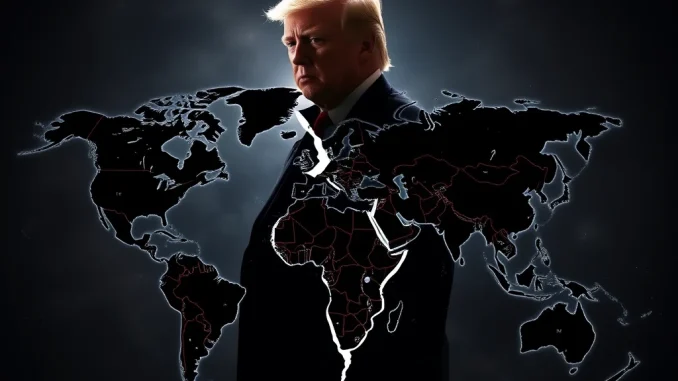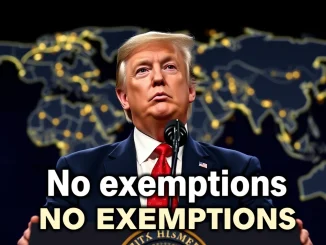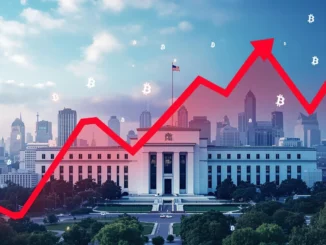
Donald Trump’s recent statements regarding changes to U.S. tariff policy have sent ripples of concern throughout the global economic landscape. While his supporters might see it as a bold move, his candid admission that these changes will be “costly and problematic” raises serious questions about the potential repercussions. Let’s dive into what this could mean for the global economy and why everyone, from crypto enthusiasts to everyday consumers, should be paying attention.
Decoding Trump’s Tariff Policy and Potential Economic Impact
During a recent Cabinet meeting, former President Trump didn’t mince words. He acknowledged that altering the current tariff policy would indeed be “costly and problematic.” This isn’t just political rhetoric; it’s a direct signal that significant shifts in international trade are on the horizon. But why is Trump revisiting tariffs, and what could be the economic impact of these changes?
- Trump’s Rationale: According to reports from Walter Bloomberg’s economic news account on X, Trump framed his decision as a necessary step because “no one else had taken it on.” This suggests a belief that previous administrations have been too lenient on trade, and drastic measures are now required.
- Short-Term Pain for Long-Term Gain?: Trump tempered his initial warning by stating that while the “transition is difficult,” the “end result will be positive.” This implies a strategy of enduring short-term economic discomfort to achieve longer-term trade advantages, presumably for the United States.
However, economists and trade experts are wary. Tariffs, essentially taxes on imported goods, can have a cascade of effects, impacting businesses, consumers, and international relations.
The Double-Edged Sword of Trump Tariffs: Benefits and Challenges
While proponents argue that Trump tariffs can protect domestic industries and create jobs, the reality is far more complex. Let’s break down the potential benefits and challenges:
Potential Benefits of Tariffs:
- Protection of Domestic Industries: Tariffs can make imported goods more expensive, thus making domestically produced goods more competitive. This could theoretically boost local manufacturing and employment in specific sectors.
- National Security: In strategic sectors like steel or semiconductors, tariffs can reduce reliance on foreign suppliers, bolstering national security.
- Negotiating Leverage: Tariffs can be used as a bargaining chip in trade negotiations, pressuring other countries to open their markets or address trade imbalances.
Significant Challenges of Tariffs:
- Increased Costs for Consumers: Tariffs are ultimately paid by consumers through higher prices for imported goods. This can lead to inflation and reduce purchasing power.
- Retaliatory Tariffs: When one country imposes tariffs, trading partners often retaliate with their own tariffs, leading to trade wars. This can disrupt global supply chains and harm businesses on both sides.
- Damage to Export Industries: Retaliatory tariffs can significantly hurt a country’s export industries, as their goods become more expensive in foreign markets.
- Reduced Economic Growth: Trade wars and increased costs due to tariffs can slow down economic growth both domestically and globally.
- Supply Chain Disruptions: Tariffs can disrupt established global supply chains, forcing businesses to find new, potentially less efficient, and more costly sources of inputs.
Examples of Tariff Impact: Learning from the Past
We don’t have to speculate about the potential impact of trade policy changes. Recent history provides us with clear examples. During his previous term, Trump implemented tariffs on steel, aluminum, and goods from China. The consequences were:
| Impact Area | Observed Effects |
|---|---|
| U.S. Steel and Aluminum Industries | Initially saw some gains, but downstream industries that use steel and aluminum faced higher costs, impacting their competitiveness. |
| Consumer Prices | Increased for goods containing steel and aluminum, and for imported Chinese goods. |
| U.S. Agriculture | Faced retaliatory tariffs from China, significantly hurting American farmers, particularly soybean producers. |
| Overall U.S. Economy | Studies suggest a negative impact on U.S. GDP growth and job creation in certain sectors, although the overall effect is still debated. |
These examples highlight the interconnectedness of the global economy. Actions taken by one major economic power, like the U.S., can have far-reaching and complex consequences.
Actionable Insights: Navigating the Uncertain Trade Landscape
So, what does this mean for businesses and individuals? Here are some actionable insights:
- Scenario Planning: Businesses should prepare for various trade scenarios, including increased tariffs and potential trade disputes. Diversifying supply chains and exploring domestic sourcing options can mitigate risks.
- Advocate for Open Trade: Businesses and consumers can voice their concerns to policymakers about the negative impacts of tariffs and advocate for open and fair trade policies.
- Stay Informed: Keep abreast of developments in trade policy and economic news. Reliable sources like Walter Bloomberg and reputable economic news outlets are crucial.
- Financial Prudence: In times of economic uncertainty driven by trade policy shifts, financial prudence is key. Consumers may need to budget for potential price increases, and businesses should manage costs carefully.
- Consider Crypto: In a world of fluctuating fiat currencies potentially impacted by trade tensions, cryptocurrencies might present themselves as an alternative asset class, though this carries its own set of risks and volatility.
Conclusion: A Problematic Path Ahead for Global Trade?
Trump’s candid admission that his proposed tariff policy changes will be “costly and problematic” is a stark warning. While the promise of a positive “end result” is offered, the historical evidence and expert opinions suggest a bumpy road ahead. The potential for increased consumer costs, retaliatory tariffs, and disruptions to the global economy are real and concerning. Navigating this uncertain trade landscape will require vigilance, adaptability, and a clear understanding of the complex interplay between trade policy and economic impact. Whether this “difficult transition” truly leads to a positive outcome remains to be seen, but the alarm bells are certainly ringing for the global economic community.



